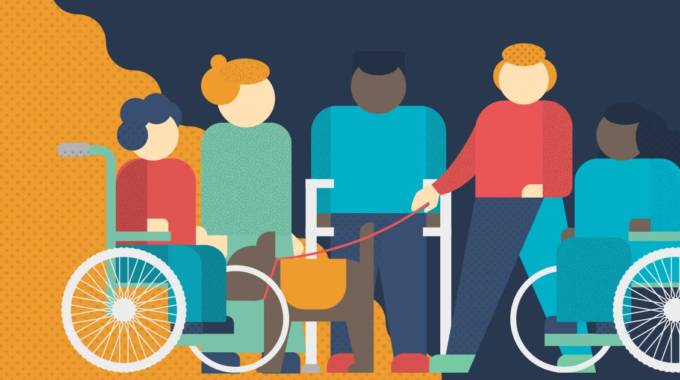
The Sunday Mail

Disability Issues
Dr Christine Peta
What is Assistive Technology (AT)? AT means any product, equipment and systems that enhance daily living, learning and working for persons with disabilities, by either increasing, maintaining or improving their functional capabilities. ACDifferent types of disabilities require different types of AT, but generally AT enhances the funcAspeaking, writing, seeing, hearing, leaQACrning, walking, typing, pointing, remembering, and many other challenges. AT helps people to live healthy, productive, independent and dignified lives, and to participate in all facets of life, including in education, work and public life.
Types of AT
AT comes in different forms that serve different purposes including mobility aids, that help people to move from place to place, such as crutches, wheelchairs, walkers, canes, prosthetic devices and orthotic devices.
Prosthetic devices also known as prostheses are artificial devices that are used to replace and compensate for a missing limb.
Orthotic devices also known as orthoses, are instruments which are applied to the human body to align, support, or correct disfigurements, or to improve the movement of joints, spine or limbs.
AT makes the life of caregivers easier, for example a mother who has a 14-year-old daughter with physical disability, does not have to carry her daughter on her back to and from school, if the child has a functional wheelchair that helps her to move on her own to and from school. There are also hearing aids that help persons with hearing impairment to hear or to hear more clearly. But as directed in Section 3.13.4 of the National Disability Policy of Zimbabwe [2021], hearing aids must not be randomly given, but they must be prescribed on the basis of audio- 2 logical assessments by qualified audio-logical technicians who are registered with the Health Professions Council.
Closed captioning may also help persons with hearing impairment to watch television programmes as well as to participate in different visual media initiatives.
Mental aids that include electrical or computer devices may help people who experience thinking, attention or memory challenges.
People with mobility and sensory impairments can also use computer and mobile devices that include computer hardware and software such as screen readers and voice recognition programmes, and screen enlargement applications. The participation of learners with disabilities in educational activities may be enhanced with the use of tools that include book holders, automatic page turners, adapted pencil grips and hearing aids.
Ramps are not the only facilities that are required to enable persons with physical disabilities such as wheelchair users to access buildings.
There is also a need to consider grab bars and wider doorways that enable access to workplaces, public and private buildings, as well as business centres, among other facilities in the built environment.
There are also some lightweight devices that enhance the participation of persons with disabilities in sports and other physical activities. Furthermore, there are other devices that can help persons with disabilities to undertake daily living activities that include dressing, grooming, and cooking.
How do you choose the right AT?
There is need to obtain an AT prescription from relevant practitioners.
Such practitioners may be physiotherapists, occupational therapists, family doctors, special education teachers, speech-language pathologists, rehabilitation engineers, and other specialists that may include officials from companies that manufacture AT.
The Department of Disability Affairs in the Ministry of Public Service, Labour and Social Welfare in partnership with UNICEF and the Clinton Health Access Initiative (CHAI) is in the process of mapping suppliers of AT and creating a database which is publicly shared in a format that is accessible to all citizens.
The database will enable persons with disabilities and parents and guardians of children with disabilities to know the location of suppliers of AT including at provincial and district levels, and to easily access appropriate AT for both adults and children with disabilities.
The National Disability Policy of Zimbabwe clearly states that there is a need for quality control of donations of AT by the Department of Disability Affairs, as some donations (in the absence of prescriptions from relevant practitioners) and certified suppliers, may turn out to be harmful to the intended beneficiaries.
Way Forward
The National Disability Policy of Zimbabwe [2021] is directing the establishment of local industrial hubs where sunscreen lotion for persons with albinism and AT is manufactured and distributed through a wide range of channels that include local pharmacies.
There is also a need for tertiary and vocational learning institutions to impart skills to students so that they can design and manufacture AT for persons with disabilities thus improving access and affordability, as opposed to importing AT from neighbouring and other countries at exorbitant prices.
Children with disabilities who require AT, must receive AT, at the earliest possible time of need and they must be timeously taught to use them, so as to avoid further developmental problems.
Caregivers and staff that work with persons with disabilities must also receive AT training.
At present, the Ministry of Public Service, Labour and Social Welfare has the mandate of providing AT to persons with disabilities in all the 10 provinces of Zimbabwe, through District Social Development Offices.
There is a need for community leaders in both rural and urban areas to identify needs of AT by persons with disabilities, and to liaise with the Ministry of Public Service, Labour and Social Welfare to facilitate provision of the same, thus enhancing the health and well-being of persons with disabilities.
Dr Christine Peta is a disability, policy, international development and research expert who is the National Director of Disability Affairs in Zimbabwe – she can be contacted on: [email protected]



